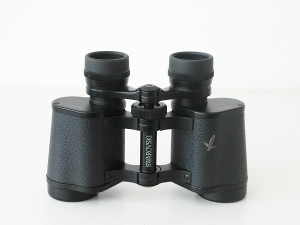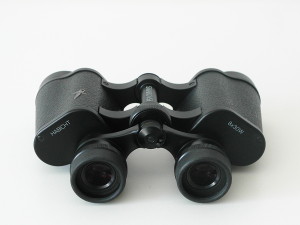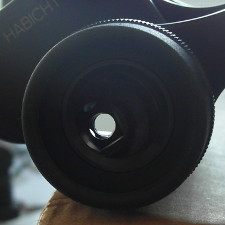


With the recently introduced CL Companion, Swarovski is currently offering two 8x30 binoculars of almost identical specifications and also the same price range, the second one being the classical Habicht 8x30 W. It might therefore be interesting to compare the properties of these fine but rather different designs.
Fig. 1: Swarovski 8x30 W Habicht (No. A774583425); right panel: Exit pupil
The Habicht is a classical binocular with Porro prisms and was initially introduced in 1949, though at that time with a somewhat larger field of view of 150m/1000m. I am not sure when precisely the transition to the current design (136m/1000m) took place, perhaps during the 1960s. On one side, the Habicht is truly old fashioned with its traditional eyepieces of short eye-relief (not suitable for spectacle-wearer). On the other side, Swarovski has equipped this device with state of the art coatings which yield a record-breaking transmission of 96%. Another outstanding feature (for a Porro-binocular with center-focus) is the fact that this instrument is waterproof. The Habicht is currently offered for 930 Euro (in Germany; street prices about 770 Euro can be found).
Fig. 2: Swarovski 8x30 CL Companion (No. K880853981)
The CL Companion of 2018 is a recent roof-prism design with an unusually compact body, fairly long eye-relief and twist-up eye-cups. It is lighter than the Habicht and conveniently fits into the pocket of a jacket, almost like a (slightly oversized) compact binocular. The CL Companion is currently offered for 1120 Euro (in Germany; street prices start about 850 Euro).
Fig. 3: The Habicht and the CL
The following table summarizes some of the specifications of the two contenders.
| Real angle | Field of view | Apparent angle | Eye relief | Exit pupil | Transmission | Close focus | Waterproof | Weight | |
| of view (deg) | (m/1000m) | of view (deg) | (mm) | diam. (mm) | (daylight, %) | (m) | (m) | (gram) | |
| Habicht 8x30 W | 7.8 | 136 | 60 | 12 | 3.75 | 96 | 3.0 | 4 | 540 |
| CL Companion 8x30 | 7.6 | 132 | 58 | 16 | 3.75 | 90 | 3.0 | 4 | 490 |
Angle of view: Both binoculars have rather similar fields, with a slight advantage for the Habicht. The fields of 136m/1000m (Habicht) and 132m/1000m (CL) are moderately wide when compared to the high-end competition (example: Swarovski 8x32 EL WB: 141m/1000m, Zeiss 8x32 Victory FL: 140m/1000m) but seem fully sufficient for most applications.
Image sharpness: Both binoculars offer a perfect sharpness near the central part of the image. The star test delivers almost point-like stars within the innermost 70% of the angle when using the Habicht. The CL Companion displays a wider sweet spot of roughly 80-85% and a superior edge-sharpness. During daytime observations of uncritical targets, the CL appears almost sharp throughout the field, while the Habicht shows a visible blur around the edges of field. Clearly, the CL does have the rather modern (and probably more complex) eyepiece design among the two contenders.
Image color: The images of both are neutral without any color tint; the Habicht may have a slightly cooler hue of its image.
Rectilinear distortion: Both binoculars display only a slight amount of pincushion distortion, the CL perhaps a little less so than the Habicht. I can sense a minor globe-effect with the CL when panning. The amount of pincushion distortion is a designer's choice who has to balance straight lines vs. globe-effect, and in both binoculars this choice appears well made.
Stray light: The Habicht is suffering a prism-leak (Fig. 1, right panel, to the lower left of the exit pupil) which causes stray-light contamination in some situations, notably during twilight or on fairly dark, gloomy days. Here, the eye-pupils are expanded and easily in contact with the prism-leak. The CL shows a far higher resistance against stray-light and keeps a high contrast under almost any condition, with the exception of direct sun-light hitting the objective lens at an angle; it would help to increase the depth of the 'lens-hood', i.e. the lengths of the optical tubes into which the objective lenses then become recessed somewhat deeper. The same holds for the Habicht (and for almost any other binocular, for that matter), but that would also increase the length of the instrument and its weight.
Ghost images: If, at night, a bright object (street lantern, moon) is positioned into the field, reflections on the air-to-glass surfaces take place, which can lead to multiple 'ghost' images of the light source. A successful suppression of these ghosts indicates a high quality of the anti-reflection coating. Not surprisingly, both binoculars are performing perfectly well in this test, any reflections of potentially practical relevance remain absent.
Chromatic aberration (CA): Here, the CL Companion is somewhat behind its contender: It displays some color fringes along edges of high contrast. Those appear to be of lower intensity through the Habicht. Nothing of terribly annoying quantity, but I would have expected the rather recent eyepiece design of the CL Companion to be slightly more CA-resilient in this part of the test.
Low light performance: The Habicht displays a clearly brighter image, especially after sunset in twilight conditions. The difference of 6% in transmission between both binoculars does not appear huge, but it may be amplified a little bit under low light, given the case that the Habicht should have a higher spectral transmission towards the blue side of the spectrum. The transmission difference between both binoculars may result from the choice of prisms (roof-prisms of Schmidt-Pechan type transmit slightly lower than Porro-prisms of comparable size) and, of course, from the rather complex optical design of the CL, which certainly contains a higher number of lens elements.
Mechanical robustness: The binoculars appear well built, they are water- and dustproof and certainly able to take some punishment, though not of military-grade intensity. Both are specified for temperatures between -25 / +50 (Centigrade, during application) and -30 / +70 (storage). There is no obvious indication here for the advantage of any binocular over its competitor.
Usage/features: With its higher eye-relief, the CL Companion may be used in combination with eye-glasses. It is very compact and also somewhat lighter than the Habicht. While the Habicht's focuser turns with significant resistance, the CL is focusing smoothly and fast. The close focus points of both contenders are identical at 3m and not supportive to the observation of insects. I do not like the way how the CL's diopter setting is implemented: A disk that turns after slightly being pressed down - I couldn't find any reasonable way to set this diopter without taking the binocular away from my eyes. A traditional solution with a diopter setting around the right eyepiece would appear preferable here. Altogether, the CL Companion is more versatile in practical use, including a superior ease of view (to me), although I tend to hold the Habicht with its wider body shape a little steadier.
| Angle of | Image (edge-) | Stray | Ghost | Color | Low | Usage/ | Mechanical | Final | |
| view | sharpness | light | image | fringing | light | features | robustness | score | |
| Habicht 8x30 W | 2 | 1 | 1 | 1.5 | 2 | 2 | 1 | 1.5 | 12 |
| CL Companion | 1 | 2 | 2 | 1.5 | 1 | 1 | 2 | 1.5 | 12 |
The 'final score' is the sum of the individual scores and is intended to serve as an orientation only.
When summarizing the features of these two contenders, we arrive at practically identical performances with very individual differences: The Habicht, being a Porro-binocular, delivers the typical 3D-stereoscopic enhancement, a very bright image, but also a weakness when it comes to stray-light resistance. The latter is somewhat annoying, because it can disturb low-light observations during which the Habicht is otherwise amazingly strong for an 8x30 binocular. Its eyepiece-design is not state of the art, with low eye-relief and moderate edge-sharpness. On the other hand, we have the CL Companion with its compact form factor, B-oculars for spectacle wearer, superior stray-light resistance and edge-sharpness, but disadvantages in terms of color fringing and brightness. It is the user's choice which one of the features are of critical importance to him, and certainly a wonderful fact that such a choice, in times when Porro-binoculars of decent quality are almost extinct, can still be made. Note that another comparison of 'old vs. new' is now completed with two Nikon binoculars.
Last modified: October 2018